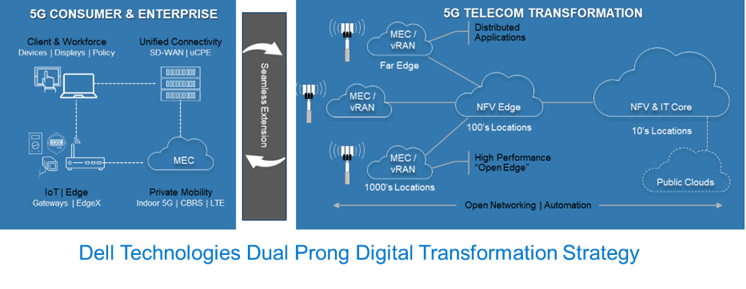Co-authored with Bob Pike, GM, Smart Edge Division at Intel
Progressive enterprises are pursuing software-defined Edge compute solutions with operating models powered by analytics, automation and machine communications to improve productivity, service-levels and cost structures. With hundreds of devices and sensors connecting to a network, wired connections are becoming expensive. At the same time, the mobile 5G networks are in early deployment and the existing 4G networks are not ready for the massive connections and the data associated with these connections coming their way. This is where on-premises distributed computing with Cloud services (aka MEC) fulfills the need.
Before the internet became a platform for services, the traditional compute models were always On-Premise. A large percentage of the enterprise workloads are still on-prem or in a Private Enterprise Data Center making the operations costly and complex. The dependency on the Public Cloud models for DevOps related activities makes it even more challenging for the Enterprise CIO. The fine balance for a CIO these days is to leverage Public Cloud and Private Cloud but at the same time, gaining greater control and security of the user/business data made possible by introducing on-prem Cloud. Except the on-prem Cloud has a new persona: “MEC” – Multi-access Edge Compute. This is where Cloud Computing becomes attractive to move certain data into the cloud and keep what is necessary on-prem.
Telco’s are rapidly evolving and looking to “cloud-enable the last mile.” Today with SD-WAN, Telcos have the opportunity to be positioned deeper into the Enterprise in front of the DMZ/Firewall. They get to be application aware and can consider providing value added network services to address issues such as low latency requirements, network resiliency and building a higher level of network context and awareness. This allows them to participate in new services and thereby net new monetization opportunities.
What all of this means is that the boundaries are starting to blur, as customers demand better performance from the continuum between internet, public, private, hybrid clouds. Telco Networks must evolve to bring in the Cloud Fabric to extend connectivity seamlessly. One aspect of providing better performance is to reduce latency, which serves as a key KPI for the Telcos. One way to reduce latency is to make architectural adjustments and leverage Cloud, especially on-prem Cloud aka MEC. The 3GPP feature CUPS (Control and User Plane Separation) is not a new feature by any means. CUPS, simply facilitates the Telcos’ ability to deploy what they can at the customer edge or provider edge and keep what they can in the central locations for orchestration and control. The main idea is to deploy the user plane (bandwidth and latency intensive) traffic local to the enterprise and leverage the existing ISP connectivity and only have the control function extended into the telco cloud. By making this simple architectural adjustment, two things emerge for a CIO to look at seriously:
- Keeping local data secured and leveraging existing connectivity models
- Costs and Operational efficiencies would vary based on the amount of control an Enterprise chooses to have in this model.
As enterprises transform their networks, both Dell Technologies and Intel are enabling virtualization of workloads and greater flexibility via software defined networking. Dell has a Dual Prong strategy as it relates to the 5G Transformation which is essential for the Telecom Transformation and is Integral for the Telecom Digital Transformation.
 Intel offers a broad portfolio of technologies for the edge and collaborates deeply across the industry, including on tools and software optimizations. As an example, Intel has launched the OpenNESS toolkit under an open-source model to continue to drive its network transformation vision at the Edge of the network. Additionally, Intel Smart Edge Software, built on open standards, enables the delivery of Dell Technologies led private mobility services with a focus around on-prem Edge.
Intel offers a broad portfolio of technologies for the edge and collaborates deeply across the industry, including on tools and software optimizations. As an example, Intel has launched the OpenNESS toolkit under an open-source model to continue to drive its network transformation vision at the Edge of the network. Additionally, Intel Smart Edge Software, built on open standards, enables the delivery of Dell Technologies led private mobility services with a focus around on-prem Edge.
By collaborating on technologies like these, Telcos can build a monetization engine to penetrate further into the Vertical Enterprise Markets (B2B or B2B2C) and capitalize on the investments they are making to evolve their networks into a Services Oriented Architecture for 5G.
